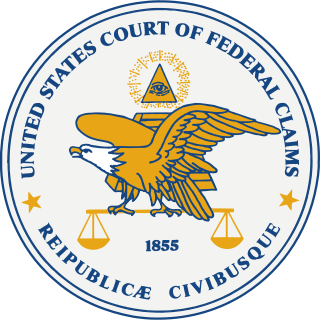
The United States Patent and Trademark Office (USPTO) is an agency in the U.S. Department of Commerce that serves as the national patent office and trademark registration authority for the United States. The USPTO's headquarters are in Alexandria, Virginia, after a 2005 move from the Crystal City area of neighboring Arlington, Virginia.

Admission to the bar in the United States is the granting of permission by a particular court system to a lawyer to practice law in the jurisdiction. Each U.S. state and jurisdiction has its own court system and sets its own rules and standards for bar admission. In most cases, a person is admitted or called to the bar of the highest court in the jurisdiction and is thereby authorized to practice law in the jurisdiction. Federal courts, although often overlapping in admission standards with states, set their own requirements.

The High Court of Justiciary is the supreme criminal court in Scotland. The High Court is both a trial court and a court of appeal. As a trial court, the High Court sits on circuit at Parliament House or in the adjacent former Sheriff Court building in the Old Town in Edinburgh, or in dedicated buildings in Glasgow and Aberdeen. The High Court sometimes sits in various smaller towns in Scotland, where it uses the local sheriff court building. As an appeal court, the High Court sits only in Edinburgh. On one occasion the High Court of Justiciary sat outside Scotland, at Zeist in the Netherlands during the Pan Am Flight 103 bombing trial, as the Scottish Court in the Netherlands. At Zeist the High Court sat both as a trial court, and an appeal court for the initial appeal by Abdelbaset al-Megrahi.

Lords of Appeal in Ordinary, commonly known as Law Lords, were judges appointed under the Appellate Jurisdiction Act 1876 to the British House of Lords, as a committee of the House, effectively to exercise the judicial functions of the House of Lords, which included acting as the highest appellate court for most domestic matters.

The United States Court of Appeals for the Federal Circuit is one of the 13 United States courts of appeals. It has special appellate jurisdiction over certain categories of specialized cases in the U.S. federal court system. Specifically, it has exclusive appellate jurisdiction over all U.S. federal cases involving patents, trademark registrations, government contracts, veterans' benefits, public safety officers' benefits, federal employees' benefits, and various other types of cases. The Federal Circuit has no jurisdiction over criminal, bankruptcy, immigration, or U.S. state law cases. It is headquartered at the Howard T. Markey National Courts Building in Washington, DC.

The Intellectual Property Office of the United Kingdom is, since 2 April 2007, the operating name of The Patent Office. It is the official government body responsible for intellectual property rights in the UK and is an executive agency of the Department for Science, Innovation and Technology (DSIT).
Business method patents are a class of patents which disclose and claim new methods of doing business. This includes new types of e-commerce, insurance, banking and tax compliance etc. Business method patents are a relatively new species of patent and there have been several reviews investigating the appropriateness of patenting business methods. Nonetheless, they have become important assets for both independent inventors and major corporations.

The Indiana Supreme Court, established by Article 7 of the Indiana Constitution, is the highest judicial authority in the state of Indiana. Located in Indianapolis, the Court's chambers are in the north wing of the Indiana Statehouse.

The United States Court of Federal Claims is a United States federal court that hears monetary claims against the U.S. government. It was established by statute in 1982 as the United States Claims Court, and took its current name in 1992. The court is the successor to trial division of the United States Court of Claims, which was established in 1855.

The Board of Immigration Appeals (BIA) is an administrative appellate body within the Executive Office for Immigration Review of the United States Department of Justice responsible for reviewing decisions of the U.S. immigration courts and certain actions of U.S. Citizenship Immigration Services, U.S Customs and Border Protection, and U.S. Immigration and Customs Enforcement. The BIA was established in 1940 after the Immigration and Naturalization Service was transferred from the United States Department of Labor to the Department of Justice.
The United States Court of Customs and Patent Appeals (CCPA) was a United States federal court which existed from 1909 to 1982 and had jurisdiction over certain types of civil disputes.

Aerotel v Telco and Macrossan's Application is a judgment by the Court of Appeal of England and Wales. The judgment was passed down on 27 October 2006 and relates to two different appeals from decisions of the High Court. The first case involved GB 2171877 granted to Aerotel Ltd and their infringement action against Telco Holdings Ltd and others. The second case concerned GB application 2388937 filed by Neal Macrossan but refused by the UK Patent Office.
The history of United States patent law started even before the U.S. Constitution was adopted, with some state-specific patent laws. The history spans over more than three centuries.

The Bar of Ireland is the professional association of barristers for Ireland, with over 2,000 members. It is based in the Law Library, with premises in Dublin and Cork. It is governed by the General Council of the Bar of Ireland, commonly called the Bar Council of Ireland, which was established in 1897. The Council is composed of twenty-five members: twenty who are elected, four co-opted, and the Attorney-General, who holds office ex officio. Every year, ten members are elected for two-year terms; five by senior counsel and five by junior counsel.

The Leahy–Smith America Invents Act (AIA) is a United States federal statute that was passed by Congress and signed into law by President Barack Obama on September 16, 2011. The law represents the most significant legislative change to the U.S. patent system since the Patent Act of 1952 and closely resembles previously proposed legislation in the Senate in its previous session.

In Canadian patent law, only “inventions” are patentable. Under the Patent Act, only certain categories of things may be considered and defined as inventions. Therefore, if a patent discloses an item that fulfills the requirements of novelty, non-obviousness and utility, it may nonetheless be found invalid on the grounds that it does not fall within one of the statutory categories of “invention”. Since the Patent Act, the categories of patentable subject matter have been defined and interpreted by Canadian courts.
Amazon.com Inc v Canada is a decision of the Federal Court of Appeal concerning the patentability of business methods within the context of the Patent Act. At issue was the patentability of a method that allowed customers shopping online to make purchases with one-click buying.
Neither computers nor software are specifically mentioned in the Canadian Patent Act. Canadian courts have held that the use of a computer in an invention neither lends, nor reduces patentability. Therefore, that an invention involves a computer is not determinative of patentability; instead, whether a computer-using invention is patentable turns on whether that invention meets the general requirements for patentability as would apply to any invention.

The following outline is provided as an overview of and topical guide to patents:
Evans v. Eaton, 20 U.S. 356 (1822), was a United States Supreme Court case in which the Court held, chiefly, that a patent on an improved machine must clearly describe how the machine differs from the prior art.













